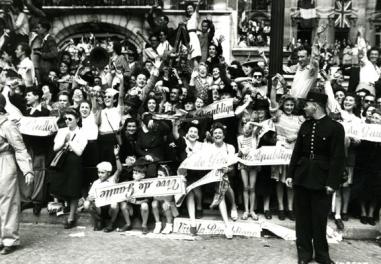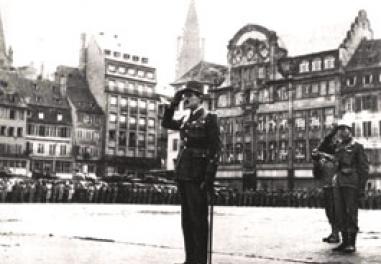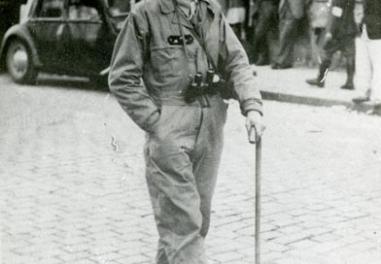Jean-Marc Berlière
Jean-Marc Berlière—a historian specialising in the French police and the Occupation—sheds light on the complex issue of the purge of French society immediately after the Liberation.

To what does the term “purge” refer? When does it occur?
Whenever there is a change of regime after periods of upheaval and social or national divisions, for political reasons, in response to public pressures, to “punish” people that have served the old regime and whose loyalty is in doubt or to create openings for supporters of the new power… “purges” are carried out with varying degrees of violence and to differing extents: this has taken place in all countries and during all periods of history. After the dramas, rifts and denouncements that characterised the four years of occupation and the virtual civil war that began in the spring of 1944 with the intensification of executions, repression, attacks and reprisals, grave dangers are posed by the excesses and thirst for vengeance and revenge that began even before the liberation of the country. For the Provisional Government of the French Republic (GPRF), created on 3 June 1944, this purge, provided for by the Order “concerning acts of collaboration” issued in Algiers on 26 June 1944, must be carried out by the State: “It is the State, the justice of the State and its authority that must prevail in France” asserts the General in Rouen in October 1944. He has to repeat this order on several occasions because it becomes clear, especially in regions that have not been liberated by the Allied or French armies—the entire South-West, from the Limousin to the Eastern Pyrenees, the Ariège to Charente, the Mediterranean South and the Alpes Maritimes to the Hérault and the Savoy region, etc.—that the official authorities established by the provisional government are being overwhelmed by acts of public vengeance and that the crimes, executions, acts of violence and barbarity which have been carried out in secret or in public since before the liberation began, are continuing, sometimes in the presence of large crowds including women and children.
The stakes are very high, including restoring the legality, image and reputation of France as perceived by the Allies and ensuring a return to the reality and exercise of power. There is clear opposition between de Gaulle, who wants to limit the purge to a “handful of scoundrels” because in the de Gaullian desire to “give France back to the French”, treason has only been committed by a tiny minority, and the Communists, whose “unyielding plan” was and remains the seizure of power, and who are seeking to take advantage of the national insurrection and the discredit cast upon institutions and administrations due to their associations with Vichy in order to impose their de facto authority symbolised by the “policing” carried out by patriotic militia and a popular or indeed revolutionary rule of law.
What is meant by “illegal purging” or “extrajudicial purging”? Who are the targets? How long does it last? What are its consequences?
“People's courts”—sometimes referred to as “revolutionary courts”—in other words, self-proclaimed courts-martial of ill-defined legality, are set up immediately after the liberation but do not put an end to the summary executions that take place without even a pretence of judgement throughout the summer and even, as is certainly the case for a third of them, after the Liberation. We use the term “extrajudicial purging” for the former and “illegal purging” for the latter, but the distinction is completely academic because the result is the same, whether the sentence is written out at the corner of a table under pressure from hate-fuelled crowds, without a preliminary inquiry or a lawyer, often based solely on rumour or public accusation, or whether it corresponds to summary executions of often villainous origin committed by perpetrators whose identities and origins are virtually impossible to determine, concealed by pseudonyms such as “Lieutenant Georges”, “Captain Bernard” or “Major Marcel”. Having started in the month of June or July in certain regions, this extrajudicial purging continues until September (a court-martial is mentioned on 28 September in Antibes), or even October (22 October in Périgueux), i.e. after the restoration of Republican legality (30 August) and the theoretical dissolution of these courts. The final toll is very difficult to determine, with the figures varying between 105,000 (a highly exaggerated figure prompted by articles written by American war correspondents shocked by the scenes that they had witnessed and who, based on their own experiences, estimated that a “blood-bath” had taken place throughout the whole of France), to 8,142 (IHTP survey of 1981, which only concerned 84 départements and is certainly an optimistic figure, as shown by subsequent studies which have led to reappraisals of approximately 50% for several départements). This total, which is impossible to confirm, could therefore be between 12 and 14,000 victims, with a minority of them sentenced by de facto courts.
This phase is followed by judicial purging. For how long does this continue? How does it occur? How many people were judged? How many of them were actually sentenced?
The government sought to regulate, organise, supervise and legalise the purges demanded by public opinion and the press. Military tribunals, but especially “courts of justice” (cours de justice) and “civic chambers” (chambres civiques)—special courts of law created for this situation with jury members appointed by the Resistance—are established with the former judging crimes set out in article 75 et seq. of the Penal Code (Code pénal), covering treason, collusion with the enemy, espionage, breaches of State security and acts harmful to national defence, and the latter judging offences not covered by these categories and often pertaining to prosecutions on grounds of a person's opinions or frequentations—declarations in favour of the Vichy regime or against the Allies, illegal feasting or black market activities, etc.—and which are punished by sentences of “national indignity” (indignité nationale), established by the Order of 26 August 1944, in which the guilty parties are deprived of their civic rights and property but retain their freedom. The Courts of Justice (one per département since the Order of 14 September 1944) and Civic Chambers were abolished in1948-1949 on dates that varied according to the départements. Military justice then took sole responsibility for judging these cases and continued to do so into the 1950s, especially for convicts required to serve sentences that had been pronounced in absentia after many years spent on the run. Ministers, Secretaries of State, Secretaries-General of the Government and the senior members of the Vichy government were tried by the High Court of Justice (Haut cour de justice). The verdicts handed down by the courts were naturally more balanced than those delivered by courts-martial, although they could still be surprising and very inconsistent according to where and when they took place. The overall outcome of this judicial purge is also difficult to determine due to the lack of accurate and reliable statistics for certain jurisdictions, although the following estimates can be made: 350,000 cases sent to the Courts of Justice and Military Tribunals. The Courts of Justice tried 125,000 people, one-third of whom were given prison sentences, 1,500 were sentenced to death and 50,000 were deprived of their civic rights. For the sake of completeness, we can add several tens of thousands of administrative internments (120, 000?)—lasting from several months to nearly two years—in camps that had very recently imprisoned victims of the Vichy regime—Drancy, Gurs, Noé, etc.—in sometimes atrocious conditions, although in certain cases, these incarcerations were intended to protect the victims from public vengeance.
Was the French administration purged?
Contrary to a persistent myth, yes, the administrative services were indeed subjected to a professional purge which concerned the prefectural body as well as the teaching profession and the judiciary. In total, 28,000 civil servants were given sanctions ranging from a simple reprimand or delayed promotion to dismissal with loss of pension rights. Taking all ranks of the police as an example, disciplinary action was taken against 1,906 police officers from the Police Headquarters (approximately 10% of the workforce), 1,136 (18.9%) officers of the Sûreté nationale (Criminal Investigation Department), 2,423 (5.24%) officers from the “Police régionale d'état” (police force controlled by the regional Prefect) and 4,108 (34.5%) members of the Groupes mobiles de réserve (GMR – paramilitary units created by the Vichy regime). This purge was all the more violent, extensive and long-lasting (with the purging commission remaining in session at the Police Headquarters for a whole year, from September 1944 to September 1945, although the after-effects of the purge—administrative disputes, reviews due to abuses of power, amnesties, reincorporations, etc —would continue into the 1970s) because it was self-purging process, carried out by the police officers themselves, driven by the desire to settle internal, personal, trade union, hierarchical or political scores as well as their professional ambitions, with the vacated positions allowing for spectacular promotions. To this can be added the pugnacity of a Communist Party seeking to avenge its arrested comrades, and above all, to make a discrete but massive entrance, via the vacated jobs, into one of the bastions of the State. At the Police Headquarters, it was a communist and railway worker—promoted for the occasion to the rank of General Inspector of Police Services with the rank of Prefect—that chaired the “Purging Commission” whose sessions were prepared by a “purging unit” led by a militant Communist inspector of the Criminal Investigation Department (Police Judiciaire) nicknamed “Robespierre” (after the instigator of the French Revolution's Reign of Terror). The most obvious consequence of this purge was the decapitation of police departments and the removal of police officers on grounds of their enthusiasm, abilities or efficiency. This led to a weakness in the profession, an incompetence and an overly cautious approach that paralysed the police in the post-war period and was partly responsible for the rise and long-lasting impunity of the organised crime that had developed in collaboration with the enemy and in the “French gestapos”.
In one of your publications, you mention the abuses that took place at the Paris Dental Institute. Could you tell us this story?
What happened at the Dental Institute (institut dentaire – ID) on the Avenue de Choisy in the 13th district of Paris, is a perfect example of this purging, illustrating the power struggles between the Provisional Government of the French Republic (GPRF) and the French Irregulars and Partisans (FTP) controlled by the Communist party, the rivalries between the French Forces of the Interior (FFI) and the FTP, illegal arrests, equally illegal sentences passed by a “people's tribunal” and the execution of people, some of whom were accused of collaboration whilst others were merely Communist “renegades” or just private citizens—victims of rumours cast by the public or their neighbours, competitors or rivals seeking to settle old scores. It also illustrates the two phases of the purge: arrests and executions of varying "legality" until the end of the fighting and then—from 7 September, with the newly restored Republican legality requiring the head of the ID to hand over the prisoners to the police and legal system—nocturnal executions on the banks of the River Seine with the bodies weighted down by a stone around the neck, which clearly shows that the killers were perfectly aware that they were acting illegally and were seeking to conceal the traces of their crimes. Between 40 and 46 people, including 11 women, were executed in this way. To this can be added the systematic thefts from victims, the looting of apartments and acts of barbarity that accompany this type of purge just about everywhere, which explains why the events in Paris are also seen in the Alpes Maritimes and the Périgord regions during the same period. While the ID was not the only centre of terror in Paris, it was the biggest and the only centre whose actions were comparable to what was happening in Pamiers, Nîmes, Limoges, Périgueux, Pressac, Nice, Antibes, etc.
Articles of the review
-
The file

The return of the Republic
De Gaulle considers that Paris—the secular heart of the French sovereign State—occupied by the Germans since 14 June 1940, embodies the "remorse of the free world." Since the Normandy Landings on 6 June 1944, the French capital has been a key strategic and political focus. ...Read more -
The event

The liberation and defence of Strasbourg
On 2 March 1941, in Koufra, following a victory that has since become legendary, Colonel Leclerc swore an oath before his men that "we shall not lay down our arms before our colours, our beautiful colours, are flying above Strasbourg cathedral". And now, in the month of November 1944, the 2nd Armour...Read more -
The figure

Philippe Leclerc de Hauteclocque
He is just 41 years of age in 1943, when de Gaulle chooses him to carry out a vital mission: the liberation of Paris. A Free Frenchman from the outset, Philippe Leclerc de Hautecloque is renowned for his daring and ability to change the course of events.
Read more

